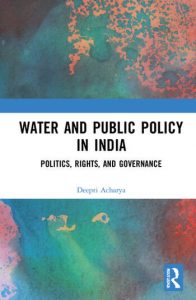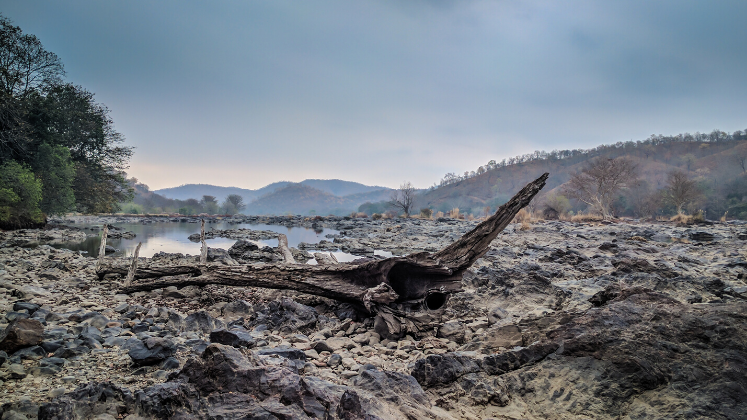In Water and Public Policy in India, Deepti Acharya explores the conceptual and theoretical frameworks behind the notion of a right to water, drawing on the evolution of water policy frameworks in India. This book enriches discourses around water justice through a water governance perspective, writes Kalrav Joshi.
Water and Public Policy in India. Deepti Acharya. Routledge India. 2021.
Find this book (affiliate link):![]()
 The ideological origins of the idea of ‘a human right to water’, which led to the institutionalisation of this notion, remain structurally flawed and deeply problematic for the interests of ‘water-poor’ states. Disseminating and channelling this top-down approach at the behest of global organisations will not resolve any of the embedded complexities – it is a fantasy that cannot achieve targets for the humanitarian water management process and prevents equality for the ‘have-nots’.
The ideological origins of the idea of ‘a human right to water’, which led to the institutionalisation of this notion, remain structurally flawed and deeply problematic for the interests of ‘water-poor’ states. Disseminating and channelling this top-down approach at the behest of global organisations will not resolve any of the embedded complexities – it is a fantasy that cannot achieve targets for the humanitarian water management process and prevents equality for the ‘have-nots’.
In light of the hegemony of the idea that water is a right, Water and Public Policy in India explores the conceptual and theoretical frameworks underpinning the ‘right to water’ and advocates using this term in place of ‘human rights to water’. According to author Deepti Acharya, the latter term is a top-down approach, whereas the former is not only comprehensive but also based on a rights-based approach. This helps in policymaking and analysis, along with setting priorities for water policy to ensure no individual is deprived of sufficient water supply. By underlining India’s national water policies, Acharya argues that this can introduce a new water policy framework at the global level.
At the international level, the concept of the ‘right to water’ has been introduced and advanced through two major discourses. The first discourse contends that this idea has arisen and developed along the course of regulation. The fundamental contention here is that worldwide organisations have distinguished water as a right and have guaranteed access to water through global interventions.
The second discourse, advanced as a component of the water justice movement, dismisses this case by arguing that genuine change has been brought about by water researchers and water activists who have pressurised states to guarantee the right to water for all. Situating these arguments in modern political thought, Acharya defines the ‘right to water’ as a ‘process that is interlinked with many aspects, including rights, duties and priorities’ (34).

Image Credit: Photo by Shridhar Vashistha on Unsplash
Positioning ‘water scarce’ states at the centre of its analysis, the book argues quite convincingly that the concept of the ‘right to water’ is only achievable when there is an established, efficient system and a just water supply, backed by rights, duties and priorities. The book interrogates the required mutual understanding between governments and individuals necessary to secure the ‘availability, accessibility and affordability’ of water for everyone. Acharya writes: ‘To maintain this condition, it is important to ensure and preserve water through policy structures’ (35).
One of the most compelling and engaging parts of the book, which is at its core, is its analysis of India’s national water policies that were drafted in 1987, 2002 and 2012 respectively. The details are revealing. The book is critical of the approaches taken by the Indian government in making national policies and identifies missing elements like the monitoring of equal water supply, specific mentions of Scheduled Tribes and Scheduled Castes and arrangements to ensure the sustenance of water resources will guarantee the right to water to every individual.
The book vehemently argues that the concept of the ‘right to water’ was completely ignored in national water policies in India. Though the entire concept of the ‘right to water’ was at a nascent stage in India, it is noteworthy that national water policies were strategy-centric, focusing on a needs-based approach for distribution and management. However, they barely focused on water justice and therefore were bound to fail given these circumstances.
The formation of national water policies in India evolved from a top-down approach to a participatory one by the national water policy of 2012. Despite this paradigm shift in policymaking, the question of public-private partnerships remains the biggest concern. The book also identifies concerns regarding the making of policy, the language used and policy implementation without a sense of the values key for the development of water discourses. The book is also an attempt to look beyond the conventional ways of relying on the legislature and the executive in policymaking, arguably positioning the Indian judiciary and civil society as key expounders of the ‘right to water’.
One of the book’s chapters focuses on the Indian understanding of the ‘right to water’ and its contours. It chronicles this right from the time of British colonial rule, where water was the subject of management and control by the central government, to the post-independence (constitutional) setting that more or less protected water as a right. Though colonial rule might have resulted in the formation of a public system of water management, it is notable that this system did not endorse water as a right. In fact, it was the subject of management, an exploitative way to have control over the rights of individuals in using water resources.
The book introduces the major traditions in the concept of water justice with a series of critiques from different ideologies including neo-Marxism, eco-feminism and post-liberalism. It moves between the academic and practical aspects of the great looming public policy challenges in the environmental space, including the power dynamics that the process is always subjected to. Questions are raised, often swaddled in data and ethics, and met with key frameworks that should pave the way for a better, egalitarian world with the equal allocation of water as a resource.
The book attempts to introduce a new water policy framework that offers a set of principles and benchmarks on which the idea of a ‘right to water’ can be based, titled the ‘Water Policy Analysis Guiding Framework’. This is a useful and important tool to analyse the contents of water laws, planning strategies and water policies that focus on realism and emphasise reality checks. Furthermore, the book intervenes by suggesting ideas and formulations for policymakers and planners. These include enriching water policies by establishing and institutionalising honest think tanks, encouraging water-related studies inclined towards water justice, undertaking rigorous academic work that can become a support system for policymakers and redefining people’s participation in water-related discourses and planning, among many other proposals.
The book could have explored a number of questions in more detail. To what extent does this concept of a ‘right to water’ pose a challenge to the existing hegemony around water governance and justice? In which ways do such interventions reflect the paradigm shifts and the looming crisis around water shortages? How is it relevant to the debates in international development and regional empowerment? Does using appropriate terminology make the concept of a ‘right to water’ more effective and less problematic? The book is nonetheless of critical importance to scholars and researchers of public policy, environment, water and law – particularly in the context of South Asian studies. It raises moral, geographical, political, social and economic questions regarding the consequences of policy formulation – economic and geographical exploitation – embedded within top-down notions of sustainable development and governance.
Acharya’s book critically evaluates the notion of the ‘right to water’ by considering a range of theories, ideologies and the practical implications of one of the most looming issues of our times. It is a significant attempt to understand discourses on rights as it pinpoints and discusses the threats for water freedoms and water equalities and it enriches water justice discourse through a water governance perspective. The question is how long the world will take to institutionalise this concept. There is a long way ahead.
Note: This review gives the views of the author, and not the position of the LSE Review of Books blog, or of the London School of Economics and Political Science. The LSE RB blog may receive a small commission if you choose to make a purchase through the above Amazon affiliate link. This is entirely independent of the coverage of the book on LSE Review of Books.







